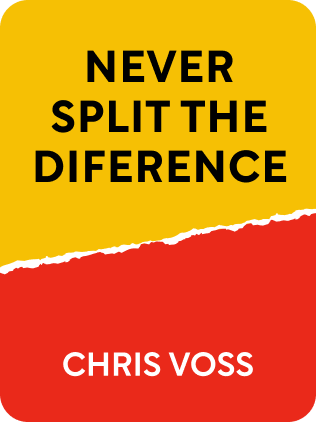

This article is an excerpt from the Shortform book guide to "Never Split the Difference" by Chris Voss and Tahl Raz. Shortform has the world's best summaries and analyses of books you should be reading.
Like this article? Sign up for a free trial here .
What role does cognitive bias play in negotiation? What biases have the greatest impact on your and your counterpart’s decision-making?
In negotiation, cognitive bias plays a crucial role in how we receive information and determine our best interests. And as a skilled negotiator, you can take advantage of universal human cognitive biases to frame your position in a way that makes it optimally attractive to your counterpart.
In this article, we’ll discuss how to use two cognitive biases (the framing effect and the loss aversion bias) to steer a negotiation in your desired direction.
Chris Voss on Cognitive Bias in Negotiation
In his book Never Split the Difference, former FBI negotiator Chriss Voss writes that you need to figure out what your counterpart’s true, underlying need is and then frame your position such that it satisfies that need. To do so, you can take advantage of their cognitive biases: mental errors in routine information processing that impact how we react to situations and form judgments.
Voss notes that advertisers understand this principle well. The products and services we purchase are usually presented to us as satisfying some deeper, more intrinsic need. When someone purchases a home-security system, they’re not really purchasing the sensor, door chimes, cameras, or home-automation technology. Instead, what they’re really buying is the peace of mind that comes with believing that their home and family are safe. That’s why advertisements for these products emphasize the emotional benefits of being able to enjoy normal life without having to think about your family being harmed or your possessions being stolen.
Similarly, Voss notes that makers of luxury products like sports cars and jewelry don’t emphasize the technical features of the vehicle or the gemological specifics of the diamond ring they’re trying to sell. Instead, they highlight the exclusivity and rarity of these goods. They do this because they know that their customers are largely driven by the need to assert their status through owning and displaying these products, which satisfies a deeper need to feel superior to others.
(Shortform note: Economists call status symbol goods like jewelry, fine champagnes, or designer jewelry Veblen goods—named for the economist Thorstein Veblen, who famously explored the phenomenon of conspicuous consumption among economic elites in 1899’s The Theory of the Leisure Class. Veblen goods differ from ordinary goods in that demand for them tends to increase as their price increases. As they become more expensive, fewer people can afford to buy them, which makes them rare. For people who wish to own such rare items to highlight their elite status, this rarity and exclusivity is precisely what makes them valuable.)
The same principle applies to your negotiating position, argues Voss. How you frame your position or offer matters just as much—if not more than—the actual substance of the position itself.
Cognitive Bias #1: The Framing Effect
The first cognitive bias in negotiation Voss points to is what’s known as the framing effect. People respond differently to identical choices based solely on how they’re presented. For example, the framing effect would make health-conscious consumers more likely to purchase milk when it’s marketed as being “99% fat-free” versus “1% fat”, believing that the first option is less fatty (even though, of course, there’s no difference between either product other than how the label positions them).
(Shortform note: A variant on the framing effect is what’s known as the valence-framing effect. Research has shown that people hold their negative opinions—in other words, what they’re against—much more strongly and confidently than their positive opinions—what they’re in favor of. In other words, we seem to dislike what we dislike more than we like what we like. In one social psychology experiment, participants who expressed a preference for fictional political candidate A over candidate B showed a notable division in how they responded to information that their preferred candidate had engaged in corruption. Those who supported candidate A because they were pro-candidate A were more willing to abandon their support in light of this information; those who favored A because they were anti-candidate B were far more likely to dismiss the corruption allegations and even double down on their support for A.)
Cognitive Bias #2: Loss Aversion
Closely related to the framing effect is the principle of loss aversion. Loss aversion makes people fear an equal loss more than they value an equal gain. Voss observes that salespeople are skillful manipulators of the loss aversion principle. When they say things like, “I just wanted to give you the opportunity to take advantage of this offer before it goes away, ” they’re creating a (usually false) feeling of urgency that triggers your sense of loss aversion. When something is framed this way, you’re no longer thinking of gaining something—you’re thinking about losing out on a potential deal.
Knowing this, you can put yourself in a strong negotiating position by framing your preferred solution as one that prevents your counterpart from incurring a loss.
For example, if you’re making an offer on a house that needs some work, you might say something like, “The house is great but it definitely needs significant contracting work. There’s foundational damage, and the gas line for the grill is too close to the house to pass inspection. I’m willing to pay cash now and absorb those costs so you don’t have to shell out that money. Plus, I’m willing to waive inspection. But if we take too long and end up having to go through inspection, I might have to start looking for other deals.”
| Loss Aversion and the “Scarcity Principle” In Influence, author Robert Cialdini argues that loss aversion is closely tied to an idea called the Scarcity Principle. The Scarcity Principle makes things with limited availability more appealing to us. Thus, rare goods are expensive and abundant items are cheap (like how gold is more valuable than iron). We’re more compelled to buy these goods because we instinctively fear that we’ll lose our opportunity if we don’t act immediately. Cialdini notes that sales professionals are skilled in using this principle to their advantage. It’s why we see so many “limited-time only” or “first-come, first-serve” sales pitches: The goal is to drive you the buyer into a loss-aversion frenzy that forces you to suspend your better judgement and rush headlong into an ill-considered decision. Knowing this, you can use the principle to your advantage by making your counterpart feel your offer has an element of scarcity built in. |
How to Frame What You Want
With this new knowledge of cognitive biases, Voss presents specific negotiating tactics to make your counterpart think about your position in the way you want them to.
Anchor their emotions by anticipating their accusations so that you acknowledge all of their fears. By preparing them for a loss, you’ll trigger their loss aversion and make them work hard just to avoid it. This also helps frame your offer as being better than worse alternatives. Even something as seemingly innocuous as prefacing a criticism with “You might hate me for saying this, but…” can achieve this. You’re priming them for an unpleasant experience. And in order to avoid that experience, they’ll start convincing themselves that what you’re telling them isn’t actually that bad—in other words, they’re already doing the mental work to avoid a “loss.”
- (Shortform note: For similar reasons, negotiators who frame their offer from the start as a way to avoid a negative outcome are more likely to succeed than those who frame their offer as a way to achieve a positive outcome.)
Let your counterpart make the first move. Remember, you don’t know enough about what you’re buying or selling to make an informed offer right away, so use their offer as a starting point. But also be aware that your counterpart might try to use this to their advantage by throwing out an extreme first offer to use framing effects against you. For example, a car dealer might ask a ludicrous price for a non-luxury vehicle, like $80,000. When you balk at this and they bring it down to a still-quite-high $50,000, the latter figure feels more reasonable by comparison, tricking you into thinking it’s a good deal.
- (Shortform note: In Influence, Robert Cialdini calls this last trick the “Rejection-Then-Retreat” tactic. Your counterpart makes an extreme first ask, which you reject, and then they counter with a more “reasonable” second offer. They’ve now primed your brain by using what’s called the contrast effect (when an unreasonable first offer makes the second offer seem more reasonable). They’ve also taken advantage of your natural empathy and desire to treat others with reciprocity—by scaling back their initial request, they’ve tricked you into thinking that they’ve offered you a concession. And they’re counting on you reciprocating their “concession” with one of your own, by saying “yes” to their second request.)
If you’re negotiating something with a monetary value, establish a range. Base it on historical examples or what the figures in comparable deals look like. Voss also advises you to properly anchor your range (where the one of the “extreme” ends of the range is actually the number you want). For example, if you’re looking to buy a new home, you could say to the seller, “Houses in this market with this many bedrooms and bathrooms typically go for between $150,000 and $180,000,” when $180,000 is really the realistic figure you’d like to pay. By framing it this way, you’re making it seem to the seller like they’re extracting maximum value from you when you’re actually just paying the price you wanted.
Be open to, and consider offering, non-monetary terms like recognition and perks. These are often small add-ins that cost nothing but can make all the difference to you or your counterpart. For example, universities are often able to secure larger philanthropic gifts from alumni donors by offering to put the donor’s name on a building or classroom on campus. This costs the university next to nothing in the way of money (they have to put some signage on the building or classroom anyway), but the non-monetary prestige of these naming opportunities often makes a huge difference to the benefactor.
Use strange numbers. Voss writes that unusual numbers sound like a product of precise calculation, even if they’re completely arbitrary. Your counterpart is far more likely to take a number like $41,972.37 seriously than $40,000 (which sounds like a placeholder or just a negotiating platform).
- (Shortform note: This is backed up by empirical research. In a study, people making an opening offer with a precise dollar amount like $19,217.32 were found by their counterparts to have superior knowledge about what was being negotiated compared to people who made round-dollar offers like $19,000. And because of this, the counterparts were willing to make bigger concessions to those making precise offers.)
Surprise your counterpart with a gift. Voss says this can even be a simple conciliatory gesture that costs you little, like an offer to pick up lunch or coffee. This engenders goodwill and triggers their natural emotional need for empathy and reciprocity. People feel the need to repay kindness with kindness.
| Frame for Success in Negotiation Harvard’s Program on Negotiation offers more techniques to frame your offer to be maximally appealing (these tactics complement Voss’s): While you want to offer a range and throw in non-monetary items and gifts, don’t overwhelm them with too many options. Sometimes people can become so bewildered and dismayed by an abundance of choices that making no decision feels like the better option. Make three offers simultaneously with different parameters, such as $50,000 for a standard package, $60,000 for a standard package on an accelerated timeline, or $75,000 for a premium package. This lets you and your counterpart figure out what’s most important to both of you and gives a choice, similar to Voss’s suggestion of establishing a range of values. When you signal a range of what you’re willing to pay, it can open a conversation about what makes you pay the low end of the range vs. the high end. Present an expensive option that’s meant to be rejected, but that makes your standard option look cheap. In the example above, the $75,000 package might not be something people choose often, but it makes the $50,000 package look cheap in comparison and thus makes them feel they’re getting a bargain. |

———End of Preview———
Like what you just read? Read the rest of the world's best book summary and analysis of Chris Voss and Tahl Raz's "Never Split the Difference" at Shortform .
Here's what you'll find in our full Never Split the Difference summary :
- Lessons learned from years as an FBI hostage negotiator
- Why negotiation is about emotional appeals, not rational ones
- The 5 methods for tactical empathy, which gets you what you want by focusing on the other person's feelings






